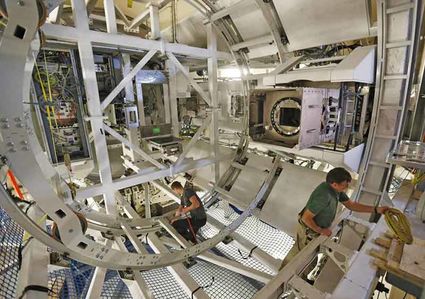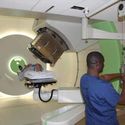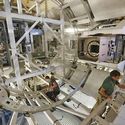"Malcolm's story" presented at May Cancer Support Group
May 30, 2018

Malcolm Obresley, of Havre, poses with his Aunt Kasie McIntosh of Chinook. Malcolm, who was diagnosed with a brain tumor about a year ago, shared his story at the May meeting of the Chinook Cancer Support Group. After six weeks of proton beam radiation therapy, a fairly new cancer therapy, he's back at work with a good prognosis. Kasie invited her nephew to present "Malcolm's story" to the local support group
Malcolm Obresley, a twenty-eight-year-old resident of Havre and a
conductor for Burlington Northern, shared his experience as a cancer
survivor at the May gathering of Chinook's Cancer Support Group.
What started as a simple "lost my glasses when I fell off a paddle
board at a family gathering" turned into a series of diagnoses and
treatments that lasted for half a year. Happily, Obresley's prognosis
is great, he's back to work and doing things he always did before his
bout with cancer. He's the nephew of Kasie McIntosh, who invited
Obresley to share "Malcolm's story" with the Chinook group
The end of last July Obresley lost his glasses during a family outing
at Seeley Lake. Back in Havre he went to the eye clinic at Northern
Hospital for an eye exam and to replace the lost glasses. When
the examiner detected an unusual response to one of the tests she
conducted a 'single eye' test. Obresley said, "My vision was always
fuzzy around the edges when I would use only one eye. I thought
it was just a function of wearing glasses." The examiner thought
something might be amiss and sent Obresley immediately for an MRI.
He was sent to a specialist in Billings.
After a visit to a neurologist in Billings and additional scans, he was
referred to the Mayo Clinic in Rochester, Minnesota. At a hospital
connected to the Mayo Clinic a section of his skull was removed, and
later replaced, in order to access the tumor discovered in his brain.
After the biopsy it was determined the tumor was a Hypothalamic
Obresley spent about a week in Minnesota recovering from the invasive procedures required for the biopsy. Then he came home for three more weeks of recuperation before returning to Minnesota to begin therapy to treat the tumor. He received proton beam radiation therapy (sometimes referred to as 'pencil beam therapy').
The start of proton beam
Radiation Therapy and how it works
The science behind the modern version of proton beam radiation was recognized in the early 1900's. In 1946 a physics professor at Harvard University first proposed the idea of using proton acceleration to treat certain types of cancer. It wasn't until 2006 that a physician in the U.S. first treated a cancer patient using spot-scanning proton therapy. This new therapy was also known as pencil-beam scanning (the name describes the ability to use a very precise beam that hits only an exact area). Currently there are only about 30 proton beam therapy machines operating in the U.S. with about a dozen more under construction.
Without trying to use too precise a scientific explanation of how the proton beam therapy works, the main advantage of the therapy is the ability to "target a patient's tumor with sub-millimeter precision while sparing nearby healthy tissues and minimizing side effects." Conventional X-ray beams deposit their energy along the path of the beam to the targeted tumor and also to healthy tissues and organs in front of or behind the tumor. The precise nature of proton beam therapy was ideally suited to treat Malcolm's brain tumor.
The 196-ton, $180 million machine does its job
Malcolm Obresley described how the proton beam therapy was used on his tumor. "The machine at Mayo," he explained, "has four stations meaning four patients can be prepared for treatment at one time but only one patient at a time can have the beam used on them. I was always flat on my back on a treatment table. Each day's treatment would be from three different angles and each angle would take about 20-30 seconds to deliver the beam." He said he never felt any thing unusual when the beam was delivered to the tumor. His treatment was once each day, five days a week for six weeks.
The part of the machine that actually emits the proton beam is attached to a huge 'gantry superstructure' that allows the beam to be adjusted to any angle. As one of the four patients is treated the other patients are repositioned for their next beam of therapy. Because the location of Obresley's tumor was so critical technicians fashioned a special mask for him. He would don the mask and then the mask would be attached to the table where he was reclining. That kept his head from moving during the beam therapy.
Needing lodging while staying in Rochester for his multi-week visits to Mayo Clinic, Obresley learned about some of the service providers partnering with the American Cancer Society to help cancer victims. While recuperating after the procedures for his diagnosis at Mayo, he lived at an Extended Stay America facility. That hotelier provides 10,000 nights of free and discounted stays to cancer patients. The Hope Lodge, another joint effort between Mayo Clinic and the American Cancer Society, provided lodging while he was receiving beam therapy treatments for six weeks.

echnicians are shown working on the gantry of a proton beam radiation therapy machine. Malcolm Obresley, of Havre, recently spoke to the Chinook Cancer Support Group about his experience with a brain tumor and proton beam therapy administered at the Mayo Clinic. The machine weighs about 190 tons and cost $180 million. There are currently 30 proton beam therapy machines in the U.S. with another dozen under construction.
Malcolm explained, "There's a lot of help for cancer victims provided through the American Cancer Society. Unless you have a need for those services, you never hear or know about them. Thank you all for your backing through this Cancer Support Group. It meant a lot when I needed those services."
Malcolm's prognosis is good
Malcolm had a checkup, after his therapy, in April of this year. The oncology doctor said, "Everything is behaving as expected. There are no problems we can see at this point." His next checkup will be in August. Malcolm added, "I suspect if things go well the periods of time between checkups will steadily lengthen."
Malcolm's cancer was first discovered last summer. After treatment he was able to return to work in January, 2018. Asked if he's had to change his lifestyle at all after the cancer, he said, "I really haven't had to give up things I like to do or limit my activities at work or at home."
He responded to a question about his mental attitude in this way, "My family was very devastated by the news that I had cancer. In my own mind I believed everything would work out. I assured myself that my worrying wouldn't change any outcome so I just tried to go with the flow. So far my prognosis is good and I feel good."









